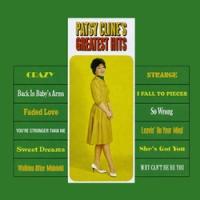Patsy Cline's Greatest Hits
Just before his death in 1959 Holly was trying to "crossover" from rock to pop. Cline had well accomplished that when she died in a private plane crash on March 5th, 1963. She was thirty years old.
The "Countrypolitan" music that the major labels were then exporting from Nashville was "country" the way Motown was "soul"—which is not to knock either one.
Berry Gordy's motto was "The Sound of Young America," not "The Sound of Black America." Major labels set up shop in Nashville to produce records designed to expand the listening and fan base.
Take pop music's then lush, string-drenched arrangements and background singer augmentation, add a dose of Floyd Cramer style upper keys tickled piano, some pedal steel and a walking bass line and you've crossed over.
While Virginia-born Patsy Cline (real name Virginia Hensley) was labeled a "country singer" the music you'll encounter here, if you're unfamiliar, is more "country-ish" than country but that doesn't make it a dilution. In fact, over time both the brilliance of the musical formula and the emotional impact of Patsy Cline's live recorded performances have only grown in stature.
Back then, variations of the production and arranging style heard here were used by most Nashville labels and recording studios. The basic sound was employed by producers like Don Law at Columbia, Chet Atkins at RCA and by Owen Bradley at "Bradley's Barn", where most if not all of these tracks were most likely recorded.
The basic sound, particularly when the producers began experimenting with stereo, was to heavily bath in natural echo the individual instruments and vocals and then to bath yet again the entirety in more echo. The "global echo"'s purpose was to produce a coherent soundstage from the dramatically spread hard left and right instruments and the vocalist marooned on a lonely island between the speakers.
Cline's powerful, resonant voice and her unerring, more-generic-than-Southern diction and phrasing plus her ability to express hurt and vulnerability (without inducing too much self-pity) helped her cross over during her lifetime. Those qualities have also helped assure her continued popularity fifty years after her death. On "I Was So Wrong" she knowingly laughs to herself so convincingly in character you think for a split second she's stopping the take.
All of that will become apparent as you play this direct connection to the recording studio reissue from Analogue Productions.
The arrangements are certainly corny and dated as is the recording and production (which is not to say the sound isn't other than sensational)). If you can't appreciate and enjoy every aspect of this record because it's dated, you probably don't get the attraction of vintage automobiles either.
Cline has influenced generations of big throated country-style singers and definitely K.D. Lang. As this collection unerringly demonstrates, she skillfully and convincingly played the dreamer, the abandoned, the betrayed and the heartbroken, aided by a deft phrasing "catch" that communicated vulnerability and hurt much the way Gene Clark also used it. She also had a vibrato that exuded steely resolve and she could punctuate a hushed confessional with an energizing dynamic flourish. She had the goods!
Like Buddy Holly after his death, by reshuffling the deck, Decca managed to issue far more albums than the catalogue had tunes. A "Greatest Hits" collection is an ideal vehicle for a singer who essentially was a singles artist and this one is filled with her many big hits, some lesser ones and a very few that are just formula. The compilation's only weakness is its mono thematic nature.
So you get Willie Nelson's "Crazy," "Sweet Dreams" (one of the most effective musical expressions of longing and rejection ever), "I Fall to Pieces" "She's Got You" and "Why Can't He Be You" among others. The public liked to hear Patsy in pain. Perhaps she played other roles on the albums, but on the hits she's just falling to pieces.
The original master tapes were transferred to lacquer at Sterling Sound by connecting the playback deck's output directly to the lathe, thereby bypassing altogether the mixing board. The sonics are sensational, particularly in terms of transparency, though the transparency is to a large tiled bathroom's worth of reverb that you have to accept going in.
Okay, it's not that bad, but there's a lot of it.
The "stereo" has instruments bunched up hard left and right with Patsy in the middle. The reverb's job is to connect the L/C/R sonic islands and it does a good job of creating an enormous, three-dimensional bubble in which are enormous three-dimensional images. There's a snare drum in "I Fall To Pieces" that will appear halfway between your speakers and your knees. It's probably due to a phasing quirk but it and the rest of the dimensionality had me saying "Who needs surround sound?"
Everything from the silent 200g pressing to the "tip-on" (paper on cardboard) gatefold jacket and the center portfolio of great full color Patsy shots screams HIGH QUALITY. This reissue, from the AAA production, to the pressing and packaging quality epitomizes the purpose of the current return to vinyl.
Warning: other than once just to have a good laugh, do not purposely concentrate on the background singers! To do so is to descend into madness! You have been warned.



